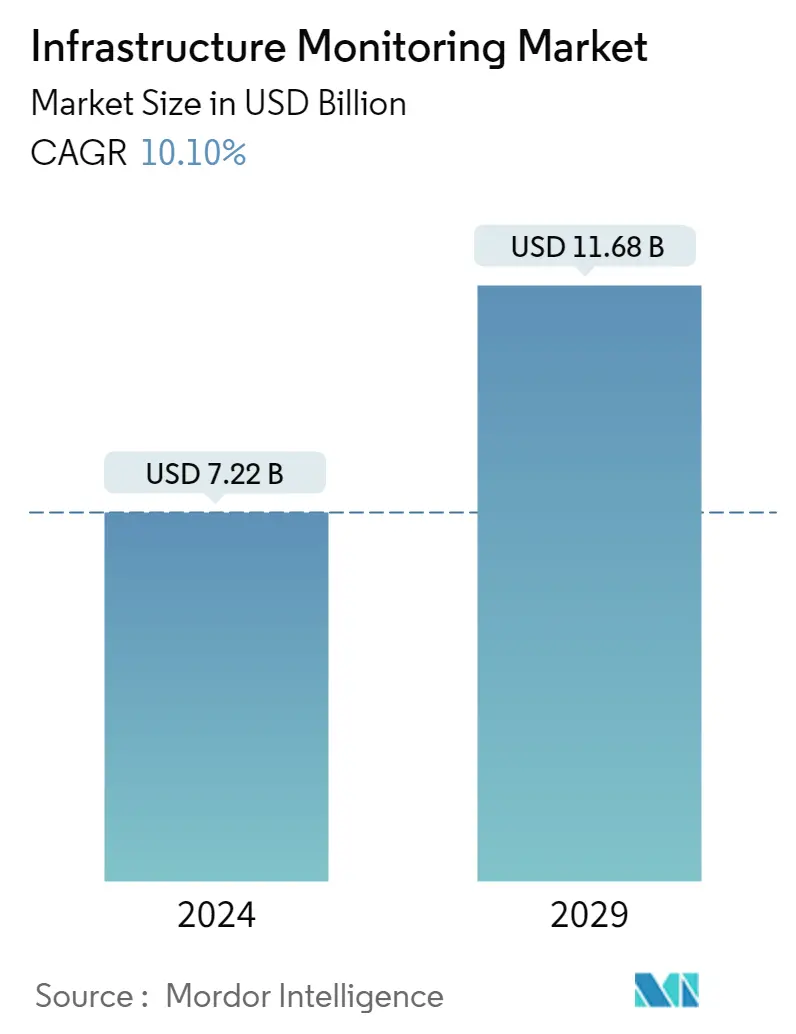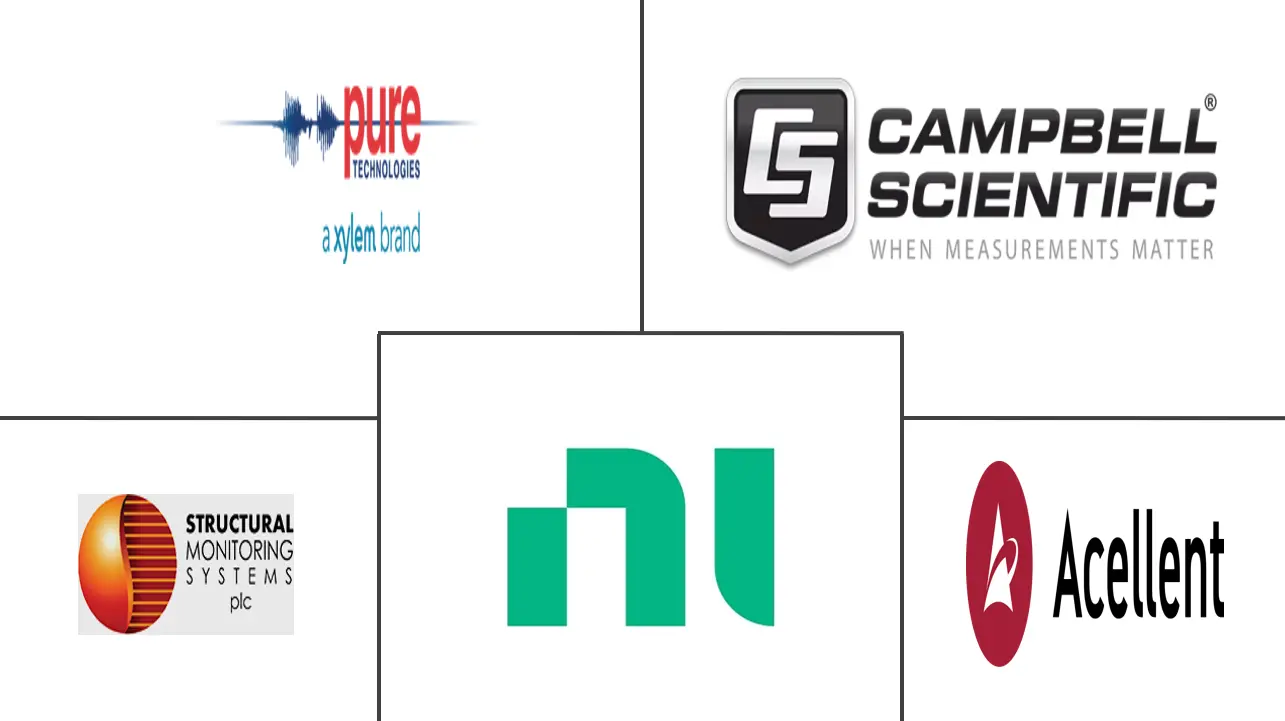Market Size of Infrastructure Monitoring Industry

| Study Period | 2019 - 2029 |
| Market Size (2024) | USD 7.22 Billion |
| Market Size (2029) | USD 11.68 Billion |
| CAGR (2024 - 2029) | 10.10 % |
| Fastest Growing Market | Asia Pacific |
| Largest Market | North America |
| Market Concentration | Low |
Major Players
*Disclaimer: Major Players sorted in no particular order |
Infrastructure Monitoring Market Analysis
The Infrastructure Monitoring Market size is estimated at USD 7.22 billion in 2024, and is expected to reach USD 11.68 billion by 2029, growing at a CAGR of 10.10% during the forecast period (2024-2029).
- The growing use of advanced sensor technologies, declining cost of sensors, growing demand for preventive maintenance, and increasing capital investments to ensure better maintenance of critical infrastructure across the end-user industries are driving the growth of the infrastructure monitoring market.
- The growing demand for predictive maintenance to reduce life cycle maintenance costs is one of the primary drivers of this industry. The MEMS (Micro electro mechanical systems) inertial sensors are extensively used in predictive condition monitoring of buildings, production systems, and even vehicles. This has been further augmented by the emergence of IoT and advanced analytics that continually improve such systems' functionality.
- In February 2022, New Relic, the observability company, declared the general availability of a new infrastructure monitoring experience especially to empower SRE, DevOps, and ITOps teams to proactively resolve and identify issues in their private, public, and hybrid cloud infrastructure. The modernized experience mainly enables engineers to instantly isolate bottlenecks by sorting and filtering based on key golden signal conditions, analyze all related telemetry (including events, logs, network, alerts, etc.) in context, visualize blast radius with topology maps and perform historical analysis to understand the various cascading impacts.
- Moreover, the ability to remotely monitor critical infrastructure using smart sensors has led to the proliferation of the market. This is extremely helpful in the end-user segments, like mining, where structural monitoring using smart sensors enables companies to save money and lives. Inertial sensors from First Sensor that can achieve resolutions of 10 µg or 0.0005° (2 arc seconds) are extensively used for remote monitoring of buildings, bridges, and wind turbines.
- Ground-penetrating radar (GPR) is also growing in importance because of its cost advantages. It is increasingly being used for bridge and tunnel inspections, roadway investigations, and to ensure adequately compacted asphalt on roads. For instance, by utilizing the GPR technology, Kentucky Transportation Center found the location of large voids in the Cumberland Gap Tunnel, which links Kentucky and Tennessee. It also significantly reduced the repair costs by using GPR to confirm that no voids needed to be fixed on one end of the tunnel.
- However, the high-cost involvement, especially in implementation and deployment, might be a significant matter of concern that can hamper the overall market's growth throughout the forecast period.
- During the COVID-19 pandemic, the companies operating in the Infrastructure Monitoring market faced temporary operative issues due to the absence of site access and disruption in the supply chain, which negatively affected the market's growth. Various associations, including those that provide multiple certifications, have also taken a hit. However, companies such as Bureau Veritas reported a 900% rise in demand for the remote inspection of offshore assets and equipment since the pandemic outbreak.
Infrastructure Monitoring Industry Segmentation
Infrastructure monitoring involves gathering and analysing data from IT systems, processes, and infrastructure in order to enhance business outcomes and provide value for the entire organisation.
The infrastructure monitoring market is segmented by technology (wired, wireless), offering (hardware, software and services), end-user industry (mining, aerospace and defense, civil infrastructure, energy), and geography (North America, Europe, Asia-Pacific, Latin America, Middle East & Africa). The market sizes and forecasts are provided in terms of value (USD) for all the above segments.
| By Technology | |
| Wired | |
| Wireless |
| By Offering | |
| Hardware | |
| Software and Services |
| By End-user Industry | |
| Mining | |
| Aerospace and Defense | |
| Civil Infrastructure | |
| Energy | |
| Other End-user Industries |
| By Geography*** | |
| North America | |
| Europe | |
| Asia | |
| Australia and New Zealand | |
| Latin America | |
| Middle East and Africa |
Infrastructure Monitoring Market Size Summary
The infrastructure monitoring market is poised for significant growth, driven by the increasing adoption of advanced sensor technologies and the declining costs associated with these sensors. The demand for predictive maintenance, aimed at reducing lifecycle maintenance costs, is a key factor propelling the industry forward. The integration of IoT and advanced analytics has further enhanced the functionality of monitoring systems, making them indispensable across various sectors. The ability to remotely monitor critical infrastructure using smart sensors has become a game-changer, particularly in industries such as mining, where it aids in cost savings and safety improvements. Technologies like ground-penetrating radar are gaining traction for their cost-effectiveness in inspections and maintenance, contributing to the market's expansion.
The energy sector is expected to be a major growth area within the infrastructure monitoring market, driven by the need for improved energy efficiency and sustainability. Structural Health Monitoring Systems offer significant benefits for both onshore and offshore assets, enabling timely and predictive maintenance. The nuclear energy sector also presents opportunities for growth, as aging infrastructure necessitates regular monitoring and maintenance. The rapid development of smart cities, particularly in regions like Asia-Pacific, is further fueling market expansion. The competitive landscape remains fragmented, with numerous small and medium-sized players innovating to meet evolving customer needs. As new players enter the market, investments are expected to rise, further driving growth.
Infrastructure Monitoring Market Size - Table of Contents
-
1. MARKET INSIGHTS
-
1.1 Market Overview
-
1.2 Porter's Five Forces Analysis
-
1.2.1 Threat of New Entrants
-
1.2.2 Bargaining Power of Buyers/Consumers
-
1.2.3 Bargaining Power of Suppliers
-
1.2.4 Threat of Substitute Products
-
1.2.5 Intensity of Competitive Rivalry
-
-
1.3 Industry Value Chain Analysis
-
1.4 Assessment of Impact of Covid-19 on the industry
-
-
2. MARKET SEGMENTATION
-
2.1 By Technology
-
2.1.1 Wired
-
2.1.2 Wireless
-
-
2.2 By Offering
-
2.2.1 Hardware
-
2.2.2 Software and Services
-
-
2.3 By End-user Industry
-
2.3.1 Mining
-
2.3.2 Aerospace and Defense
-
2.3.3 Civil Infrastructure
-
2.3.4 Energy
-
2.3.5 Other End-user Industries
-
-
2.4 By Geography***
-
2.4.1 North America
-
2.4.2 Europe
-
2.4.3 Asia
-
2.4.4 Australia and New Zealand
-
2.4.5 Latin America
-
2.4.6 Middle East and Africa
-
-
Infrastructure Monitoring Market Size FAQs
How big is the Infrastructure Monitoring Market?
The Infrastructure Monitoring Market size is expected to reach USD 7.22 billion in 2024 and grow at a CAGR of 10.10% to reach USD 11.68 billion by 2029.
What is the current Infrastructure Monitoring Market size?
In 2024, the Infrastructure Monitoring Market size is expected to reach USD 7.22 billion.

